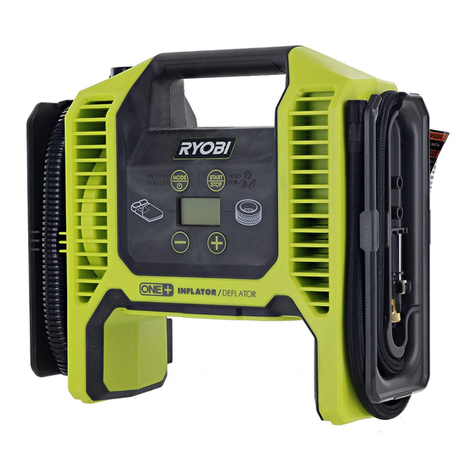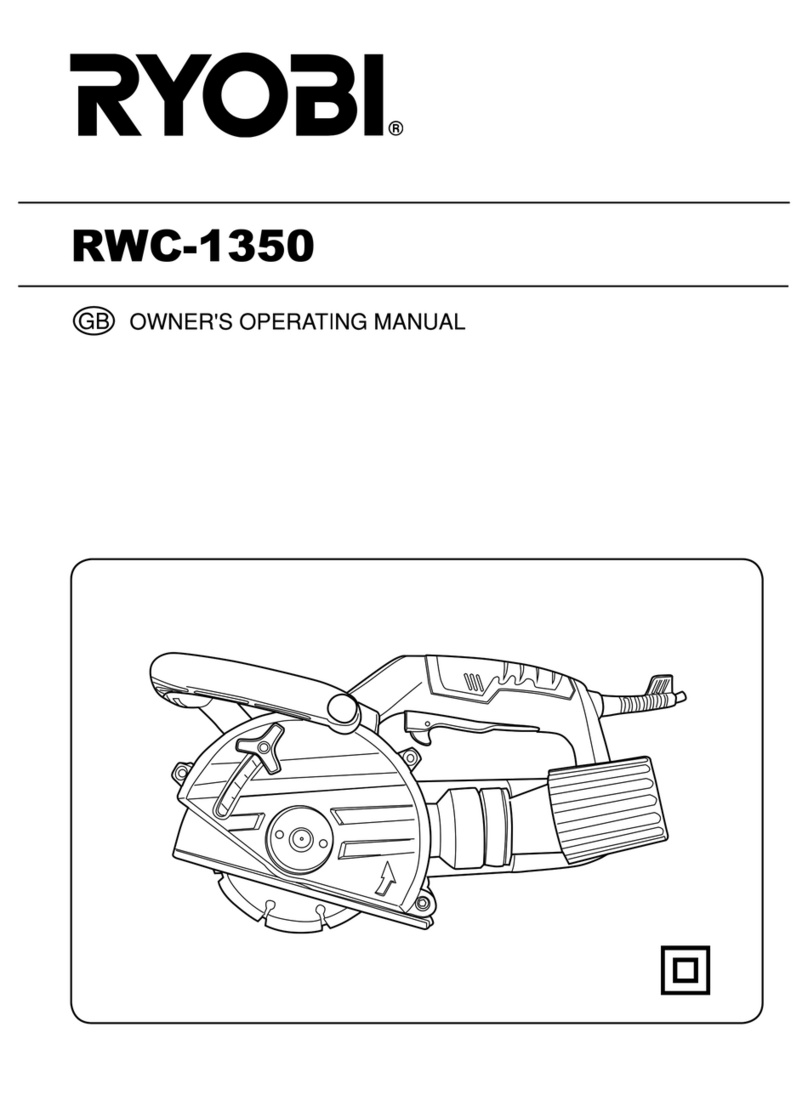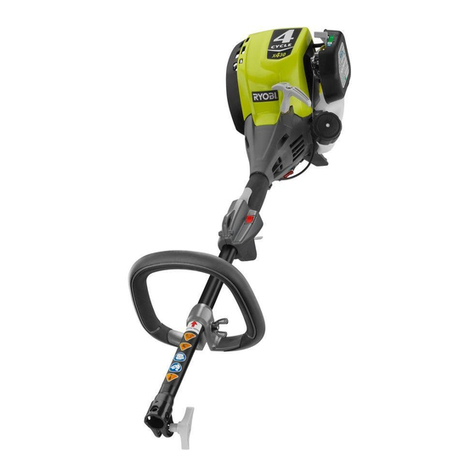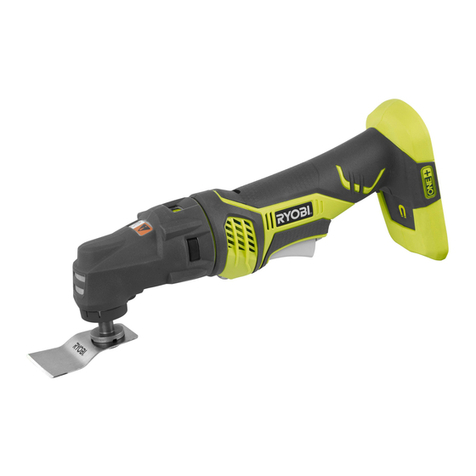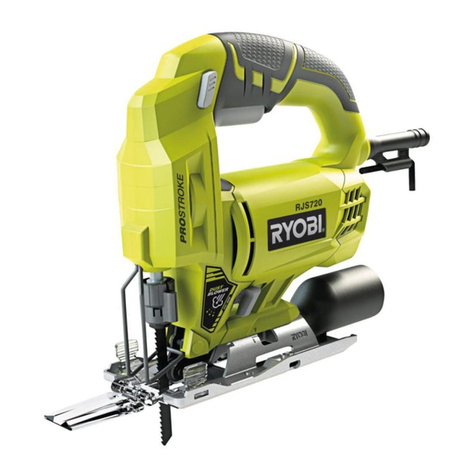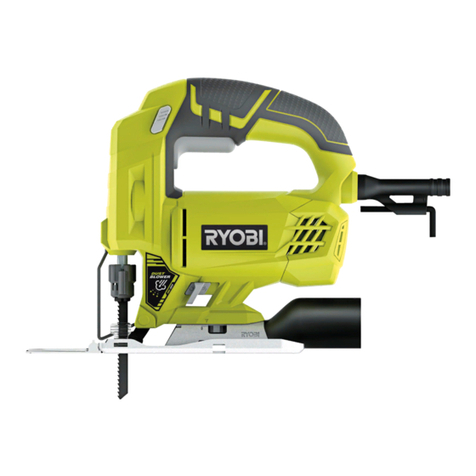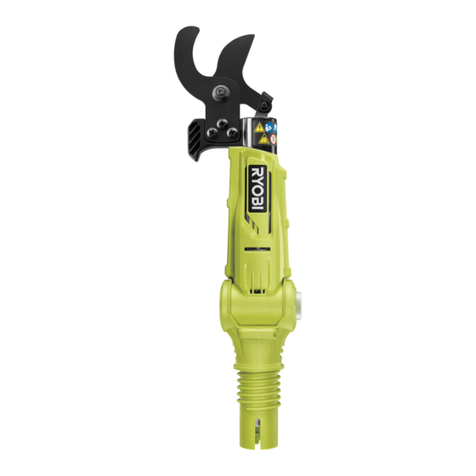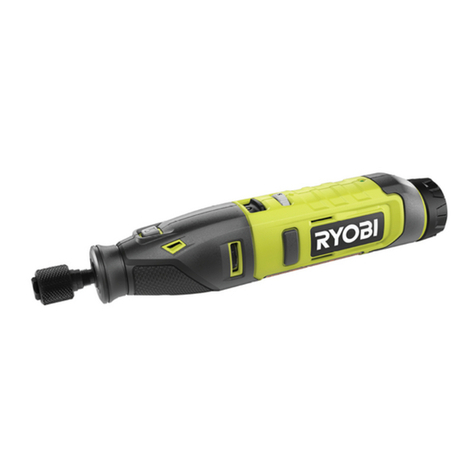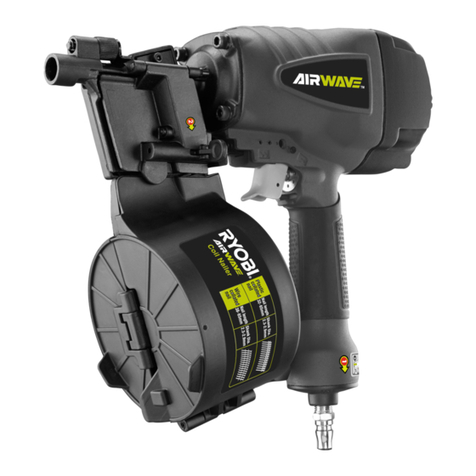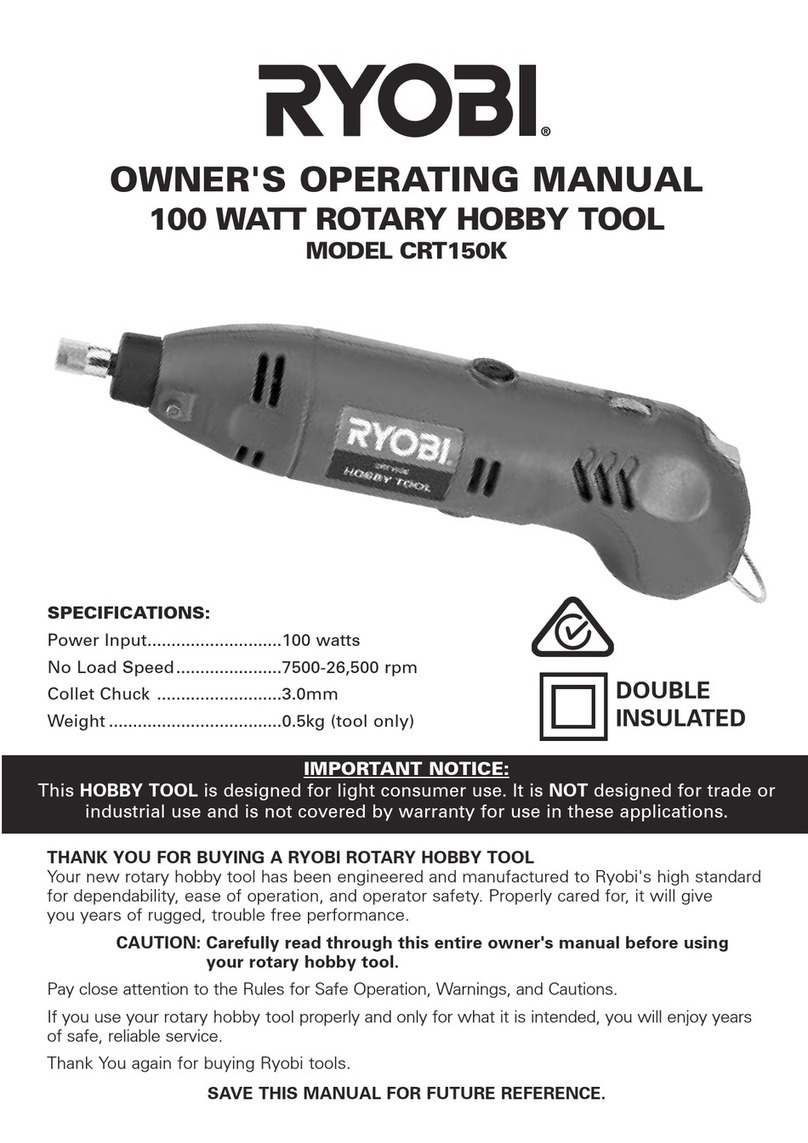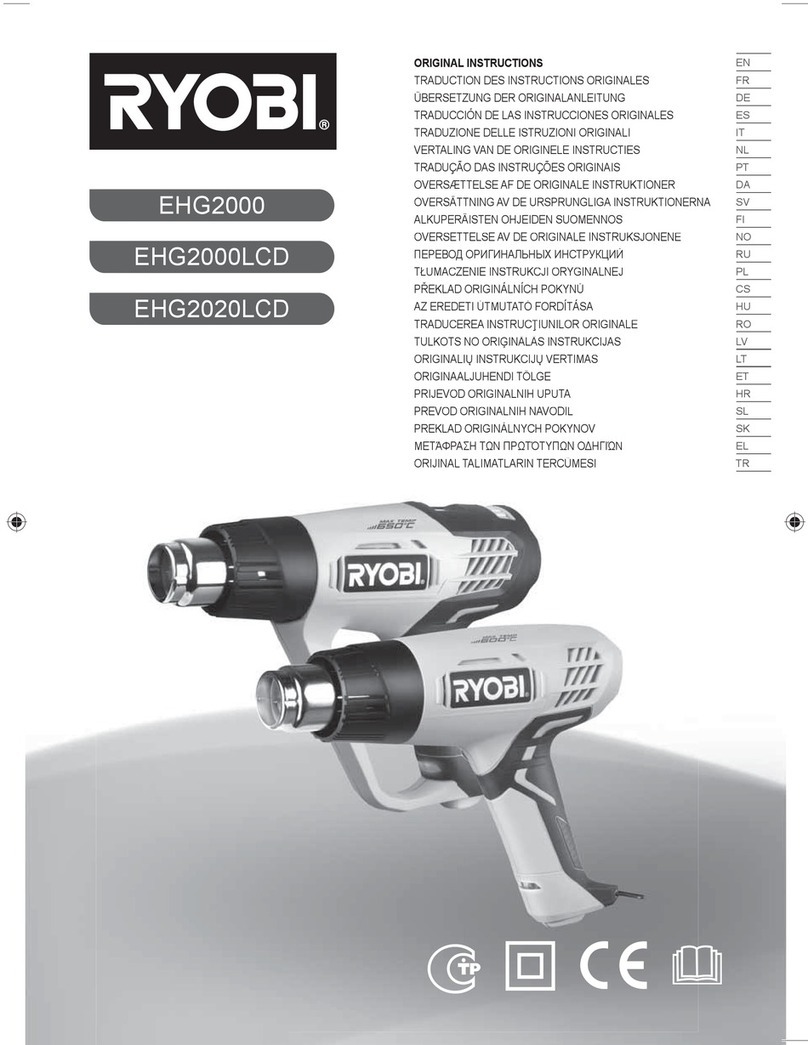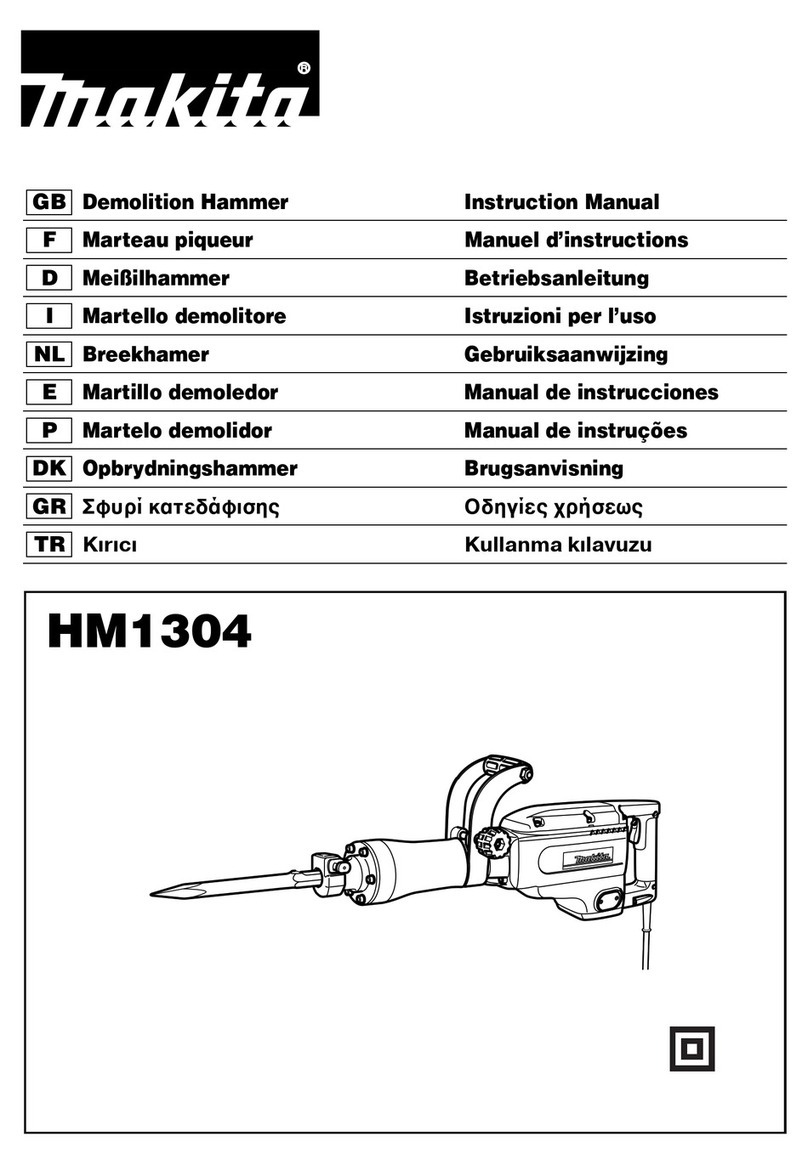Ryobi AirStrike P360 User manual

OPERATOR’S MANUAL
MANUEL D’UTILISATION
MANUAL DEL OPERADOR
18 V AirStrike™STAPLER
AGRAFEUSE DE AirStrike™18 V
GRAPADORA DE AirStrike™18 V
P360
TABLE OF CONTENTS
****************
General Power Tool
Safety Warnings..............................2-3
Stapler Safety Warnings..................3-5
Symbols..............................................6
Glossary .............................................7
Features..............................................7
Assembly............................................7
Operation.......................................8-10
Maintenance.....................................11
Troubleshooting................................11
Figures (Illustrations) ...................12-13
Parts Ordering
and Service ........................Back page
TABLE DES MATIÈRES
****************
Avertissements de sécurité générales
relatives aux outils électriques........2-3
Avertissements de sécurité relatifs
agrafeuse ........................................3-5
Symboles............................................6
Glossaire.............................................7
Caractéristiques .................................7
Assemblage........................................7
Utilisation ......................................8-10
Entretien ...........................................11
Dépannage .......................................11
Figures (illustrations)....................12-13
Commande de pièces
et dépannage ...................Page arrière
ÍNDICE DE CONTENIDO
****************
Advertencias de seguridad generales
para herramientas eléctrica........... 2-3
Advertencias de seguridad de
grapadora de puntillas................... 3-5
Símbolos............................................6
Glosario de términos .........................7
Características...................................7
Armado..............................................7
Funcionamiento........................... 8-10
Mantenimiento.................................11
Corrección de problemas................11
Figuras (illustraciones)............... 12-13
Pedidos de piezas
y servicio.......................Pág. posterior
WARNING: To reduce the
risk of injury, the user must read and
understand the operator’s manual
before using this product.
ADVERTENCIA: Para
reducir el riesgo de lesiones, el usuario
debe leer y comprender el manual del
operador antes de usar este producto.
AVERTISSEMENT :
Pour
réduire les risques de blessures,
l’utilisateur doit lire et veiller à bien
comprendrele manueld’utilisation avant
d’employer ce produit.
SAVE THIS MANUAL FOR
FUTURE REFERENCE CONSERVER CE MANUEL
POUR FUTURE RÉFÉRENCE
GUARDE ESTE MANUAL
PARA FUTURAS CONSULTAS

2 — English
GENERAL POWER TOOL SAFETY WARNINGS
WARNING
Read all safety warnings and all instructions. Failure to
follow the warnings and instructions may result in electric
shock, fire and/or serious injury.
Save all warnings and instructions for future reference.
The term “power tool” in the warnings refers to your mains-
operated (corded) power tool or battery-operated (cordless)
power tool.
WORK AREA SAFETY
Keep work area clean and well lit. Cluttered or dark
areas invite accidents.
Do not operate power tools in explosive atmospheres,
such as in the presence of flammable liquids, gases
or dust. Power tools create sparks which may ignite the
dust or fumes.
Keep children and bystanders away while operating a
power tool. Distractions can cause you to lose control.
ELECTRICAL SAFETY
Power tool plugs must match the outlet. Never modify
the plug in any way. Do not use any adapter plugs with
earthed (grounded) power tools. Unmodified plugs and
matching outlets will reduce risk of electric shock.
Avoid body contact with earthed or grounded surfaces
such as pipes, radiators, ranges and refrigerators.
There is an increased risk of electric shock if your body
is earthed or grounded.
Do not expose power tools to rain or wet conditions.
Water entering a power tool will increase the risk of
electric shock.
Do not abuse the cord. Never use the cord for carrying,
pulling or unplugging the power tool. Keep cord away
from heat, oil, sharp edges or moving parts. Damaged
or entangled cords increase the risk of electric shock.
When operating a power tool outdoors, use an
extension cord suitable for outdoor use. Use of a cord
suitable for outdoor use reduces the risk of electric shock.
If operating a power tool in a damp location is
unavoidable, use a ground fault circuit interrupter
(GFCI) protected supply. Use of a GFCI reduces the
risk of electric shock.
Use battery only with charger listed. For use with 18V
nickel-cadmium and 18V lithium-ion battery packs,
see tool/appliance/battery pack/charger correlation
supplement 987000-432.
PERSONAL SAFETY
Stay alert, watch what you are doing and use common
sense when operating a power tool. Do not use a
power tool while you are tired or under the influence of
drugs, alcohol or medication. A moment of inattention
while operating power tools may result in serious personal
injury.
Use personal protective equipment. Always wear eye
protection. Protective equipment such as dust mask,
non-skid safety shoes, hard hat, or hearing protection
used for appropriate conditions will reduce personal
injuries.
Prevent unintentional starting. Ensure the switch is in
the off-position before connecting to power source
and/or battery pack, picking up or carrying the tool.
Carrying power tools with your finger on the switch or
energising power tools that have the switch on invites
accidents.
Remove any adjusting key or wrench before turning
the power tool on. A wrench or a key left attached to
a rotating part of the power tool may result in personal
injury.
Do not overreach. Keep proper footing and balance
at all times. This enables better control of the power tool
in unexpected situations.
Dress properly. Do not wear loose clothing or
jewellery. Keep your hair, clothing and gloves away
from moving parts. Loose clothes, jewellery or long hair
can be caught in moving parts.
If devices are provided for the connection of dust
extraction and collection facilities, ensure these are
connected and properly used. Use of dust collection
can reduce dust-related hazards.
Do not wear loose clothing or jewelry. Contain long
hair. Loose clothes, jewelry, or long hair can be drawn
into air vents.
Do not use on a ladder or unstable support. Stable
footing on a solid surface enables better control of the
power tool in unexpected situations.
POWER TOOL USE AND CARE
Do not force the power tool. Use the correct power
tool for your application. The correct power tool will
do the job better and safer at the rate for which it was
designed.
Do not use the power tool if the switch does not turn
it on and off. Any power tool that cannot be controlled
with the switch is dangerous and must be repaired.
Disconnect the plug from the power source and/or
the battery pack from the power tool before making
any adjustments, changing accessories, or storing
power tools. Such preventive safety measures reduce
the risk of starting the power tool accidentally.
Store idle power tools out of the reach of children and
do not allow persons unfamiliar with the power tool
or these instructions to operate the power tool. Power
tools are dangerous in the hands of untrained users.
Maintain power tools. Check for misalignment or
binding of moving parts, breakage of parts and any
other condition that may affect the power tool’s
operation. If damaged, have the power tool repaired
before use. Many accidents are caused by poorly
maintained power tools.

3 — English
GENERAL POWER TOOL SAFETY WARNINGS
Keep cutting tools sharp and clean. Properly maintained
cutting tools with sharp cutting edges are less likely to
bind and are easier to control.
Use the power tool, accessories and tool bits etc.
in accordance with these instructions, taking into
account the working conditions and the work to be
performed. Use of the power tool for operations different
from those intended could result in a hazardous situation.
BATTERY TOOL USE AND CARE
Recharge only with the charger specified by the
manufacturer. A charger that is suitable for one type
of battery pack may create a risk of fire when used with
another battery pack.
Use power tools only with specifically designated
battery packs. Use of any other battery packs may create
a risk of injury and fire.
When battery pack is not in use, keep it away from
other metal objects, like paper clips, coins, keys, nails,
screws or other small metal objects, that can make a
connection from one terminal to another. Shorting the
battery terminals together may cause burns or a fire.
Under abusive conditions, liquid may be ejected from
the battery; avoid contact. If contact accidentally
occurs, flush with water. If liquid contacts eyes,
additionally seek medical help. Liquid ejected from the
battery may cause irritation or burns.
SERVICE
Have your power tool serviced by a qualified repair
person using only identical replacement parts. This will
ensure that the safety of the power tool is maintained.
When servicing a power tool, use only identical
replacement parts. Follow instructions in the
Maintenance section of this manual. Use of unauthorized
parts or failure to follow Maintenance instructions may
create a risk of shock or injury.
Always assume that the tool contains fasteners. Care-
less handling of the stapler can result in unexpected firing
of staples and personal injury.
Do not point the tool towards yourself or anyone
nearby. Unexpected triggering will discharge the staple
causing an injury.
Do not actuate the tool unless the tool is placed firmly
against the workpiece. If the tool is not in contact with
the workpiece, the staple may be deflected away from
your target.
Disconnect the tool from the power source when the
fastener jams in the tool. While removing a jammed
fastener, the tacker may be accidentally activated if it is
plugged in.
Use caution while removing a jammed staple. The
mechanism may be under compression and the staple
may be forcefully discharged while attempting to free a
jammed condition.
Do not use this tool for fastening electrical cables.
It is not designed for electric cable installation and may
damage the insulation of electric cables thereby causing
electric shock or fire hazards.
Hold power tool by insulated gripping surfaces, when
performing an operation where the fastener may con-
tact hidden wiring. Fasteners contacting a “live” wire
may make exposed metal parts of the power tool “live”
and could give the operator an electric shock.
Know your power tool. Read operator’s manual care-
fully. Learn its applications and limitations, as well as
the specific potential hazards related to this power
tool. Following this rule will reduce the risk of electric
shock, fire, or serious injury.
Always wear eye protection with side shields marked
to comply with ANSI Z87.1. Everyday glasses have only
impact resistant lenses. They are not safety glasses. Fol-
lowing this rule will reduce the risk of serious personal
injury.
Eye protection which conforms to ANSI specifications
and provides protection against flying particles both
from the FRONT and SIDE should ALWAYS be worn
by the operator and others in the work area when
loading, operating or servicing this tool. Eye protection
is required to guard against flying fasteners and debris,
which could cause severe eye injury.
The employer and/or user must ensure that proper
eye protection is worn. We recommend Wide Vision
Safety Mask for use over eyeglasses or standard safety
glasses that provide protection against flying particles
both from the front and side. Always use eye protection
which is marked to comply with ANSI Z87.1.
STAPLER SAFETY WARNINGS

4 — English
STAPLER SAFETY WARNINGS
Additional safety protection will be required in some
environments. For example, the working area may in-
clude exposure to noise level which can lead to hearing
damage. The employer and user must ensure that any
necessary hearing protection is provided and used by the
operator and others in the work area. Some environments
will require the use of head protection equipment. When
required, the employer and user must ensure that head
protection conforming to ANSI Z89.1-1997 is used.
Keep fingers away from trigger when not driving fasten-
ers to avoid accidental firing
.
Use safety equipment. Always wear eye protection.
Dust mask, nonskid safety shoes, hard hat, or hearing
protection must be used for appropriate conditions.
Protect your lungs. Wear a face or dust mask if the
operation is dusty. Following this rule will reduce the
risk of serious personal injury.
Protect your hearing. Wear hearing protection during
extended periods of operation. Following this rule will
reduce the risk of serious personal injury.
Battery tools do not have to be plugged into an elec-
trical outlet; therefore, they are always in operating
condition. Be aware of possible hazards when not
using your battery tool or when changing accessories.
Following this rule will reduce the risk of electric shock,
fire, or serious personal injury.
Do not place battery tools or their batteries near fire
or heat. This will reduce the risk of explosion and pos-
sibly injury.
Use the tool only for its intended use. Do not discharge
fasteners into open air.
Use the tool only for the purpose for which it was
designed.
Use only the staples recommended for this tool. Use
of the wrong staples could result in poor staple feeding,
jammed staples, and staples leaving the tool at erratic
angles. If staples are not feeding smoothly and properly,
discontinue their use immediately. Jammed and improp-
erly feeding staples could result in serious personal injury.
Never use this tool in a manner that could cause a
fastener to be directed toward anything other than
the workpiece.
Do not use the tool as a hammer.
Always carry the tool by the handle.
Do not alter or modify this tool from the original design
or function without approval from the manufacturer.
Always be aware that misuse and improper handling
of this tool can cause injury to yourself and others.
Never clamp or tape the trigger or workpiece contact
in an actuated position.
Never leave tool unattended if the battery is installed.
Do not operate this tool if it does not contain a legible
warning label.
Keep the tool and its handle dry, clean and free from
oil and grease. Always use a clean cloth when clean-
ing. Never use brake fluids, gasoline, petroleum-based
products, or any strong solvents to clean your tool. Fol-
lowing this rule will reduce the risk of loss of control and
deterioration of the enclosure plastic.
OPERATION
Do not use tool if trigger does not actuate properly.
Any tool that cannot be controlled with the trigger is
dangerous and must be repaired.
Check operation of the workpiece contact mechanism
frequently. Do not use the tool if the workpiece contact
mechanism is not working correctly as accidental driving
of a fastener may result. Do not interfere with the proper
operation of the workpiece contact mechanism.
Do not use a tool that does not work correctly.
Always assume that the tool contains fasteners.
Do not carry the tool from place to place holding the
trigger. Accidental discharge could result.
Always handle the tool with care:
• Respect the tool as a working implement.
• Never engage in horseplay.
• Never pull the trigger unless nose is directed toward the
work.
• Keep others a safe distance from the tool while tool is in
operation as accidental actuation may occur, possibly
causing injury.
Choice of triggering method is important. Check
manual for triggering options.
The stapler is designed for single-hand use. Do not
hold the tool by the front of the magazine. Do not put
hands, head, or other parts of your body near the bottom
of the magazine where the staple exits the tool, as serious
personal injury could result.
Do not point the tool toward yourself or anyone
whether it contains fasteners or not.
Do not actuate the tool unless you intend to drive a
fastener into the workpiece.
Always ensure that the workpiece contact is fully posi-
tioned above the workpiece. Positioning the workpiece
contact only partially above the workpiece could cause
the fastener to miss the workpiece completely and result
in serious personal injury.

5 — English
Do not drive fasteners near edge of material. The
workpiece may split causing the fastener to ricochet,
injuring you or a co-worker. Be aware that the fastener
may follow the grain of the wood, causing it to protrude
unexpectedly from the side of the work material or de-
flect, possibly causing injury.
Keep hands and body parts clear of immediate work
area. Hold workpiece with clamps when necessary to
keep hands and body out of potential harm. Be sure the
workpiece is properly secured before pressing the fas-
tener against the material. The workpiece contact may
cause the work material to shift unexpectedly.
Keep face and body parts away from back of the tool
cap when working in restricted areas. Sudden recoil
can result in impact to the body, especially when driving
fasteners into hard or dense material.
During normal use the tool will recoil immediately
after driving a fastener. This is a normal function of
the tool. Do not attempt to prevent the recoil by holding
the stapler against the work. Restriction to the recoil can
result in a second fastener being driven from the stapler.
Grip the handle firmly, let the tool do the work and do not
place second hand on top of tool or near exhaust at any
time. Failure to heed this warning can result in serious
personal injury.
Do not drive fasteners on top of other fasteners or with
the tool at an overly steep angle as this may cause
deflection of fasteners which could cause injury.
LOADING TOOL
Do not load the tool with fasteners when any one of the
operating controls is activated.
When loading tool:
Never place a hand or any part of body in fastener dis-
charge area of tool.
Never point tool at anyone.
Do not pull the trigger or depress the workpiece contact
as accidental actuation may occur, possibly causing
injury.
SAVE THESE INSTRUCTIONS
Refer to them frequently and use them to instruct others
who may use this tool. If you loan someone this tool, loan
them these instructions also.
STAPLER SAFETY WARNINGS
WARNING:
This product and some dust created by power sanding, sawing, grinding, drilling, and other construction activities
may contain chemicals, including lead, known to the State of California to cause cancer, birth defects, or other
reproductive harm. Wash hands after handling.
Some examples of these chemicals are:
• lead from lead-based paints,
• crystalline silica from bricks and cement and other masonry products and,
• arsenic and chromium from chemically treated lumber.
Your risk from exposure to these chemicals varies, depending on how often you do this type of work. To reduce your
exposure, work in a well-ventilated area and with approved safety equipment, such as dust masks that are specially
designed to filter out microscopic particles.
CALIFORNIA PROPOSITION 65
Table of contents
Languages:
Other Ryobi Power Tools manuals
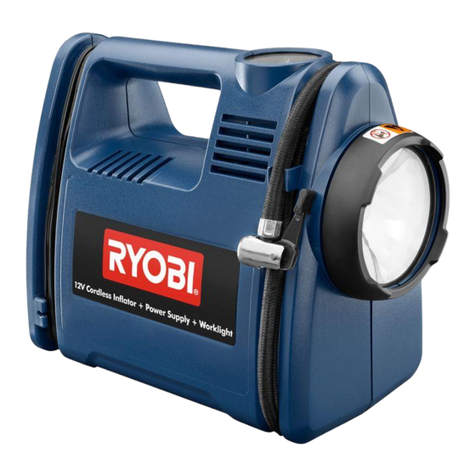
Ryobi
Ryobi YN500A User manual
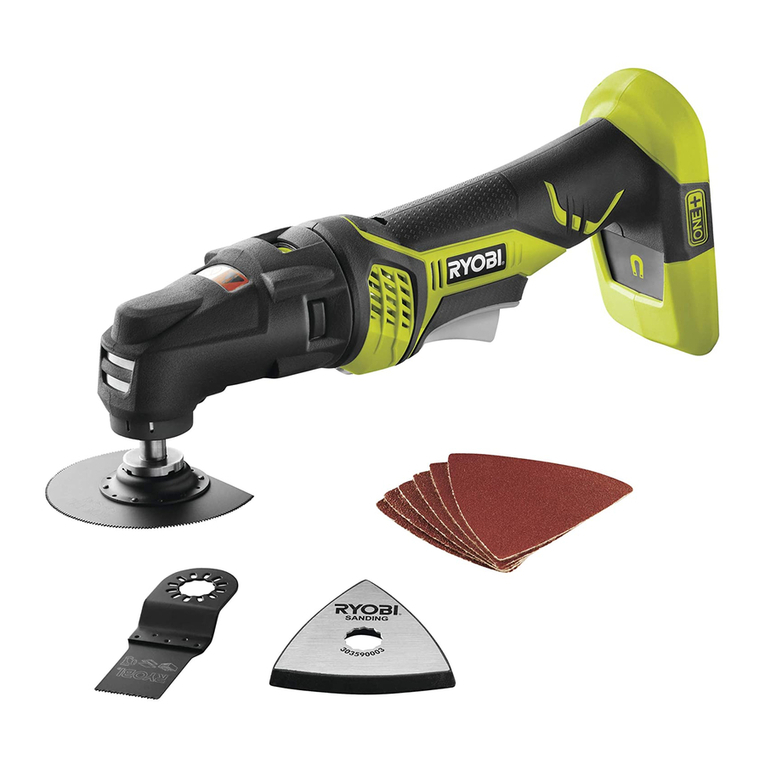
Ryobi
Ryobi JOBPLUS P570 User manual

Ryobi
Ryobi ERT1400RG Operation manual
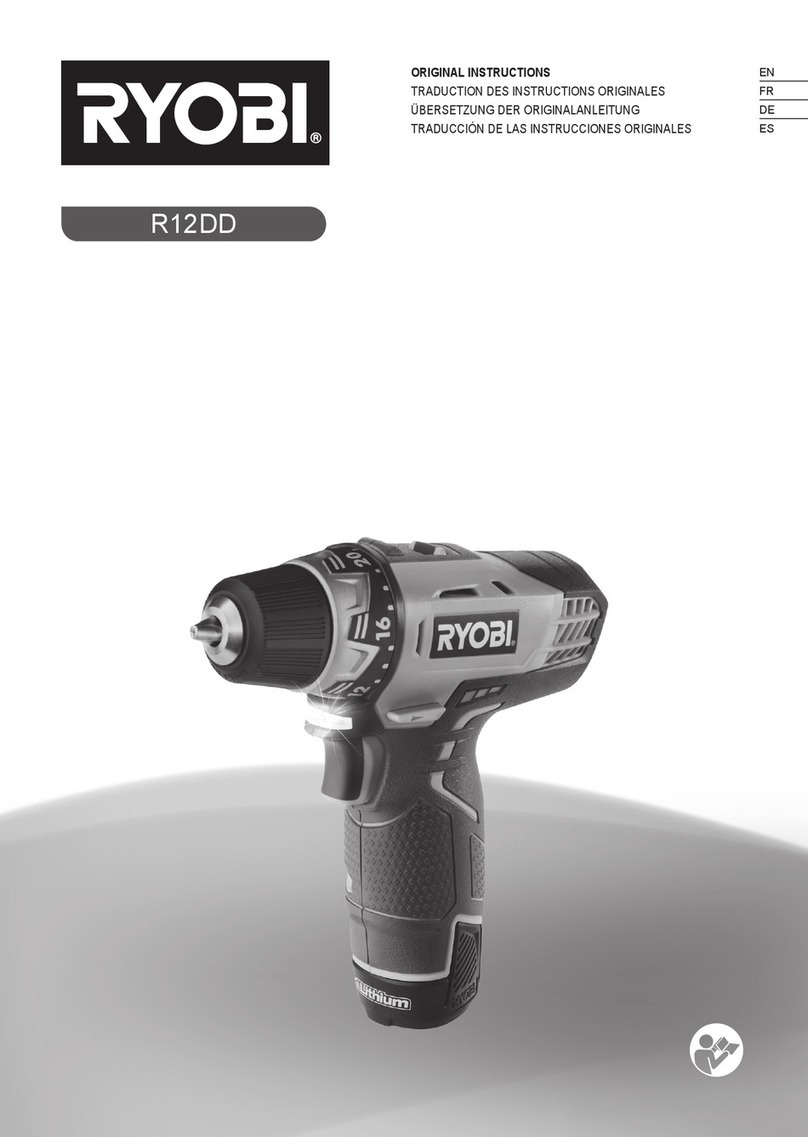
Ryobi
Ryobi R12DD User manual
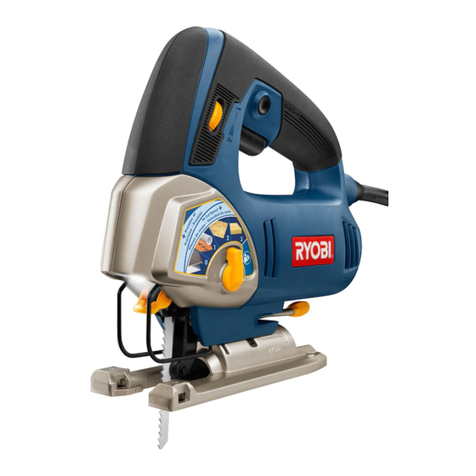
Ryobi
Ryobi JS480L User manual
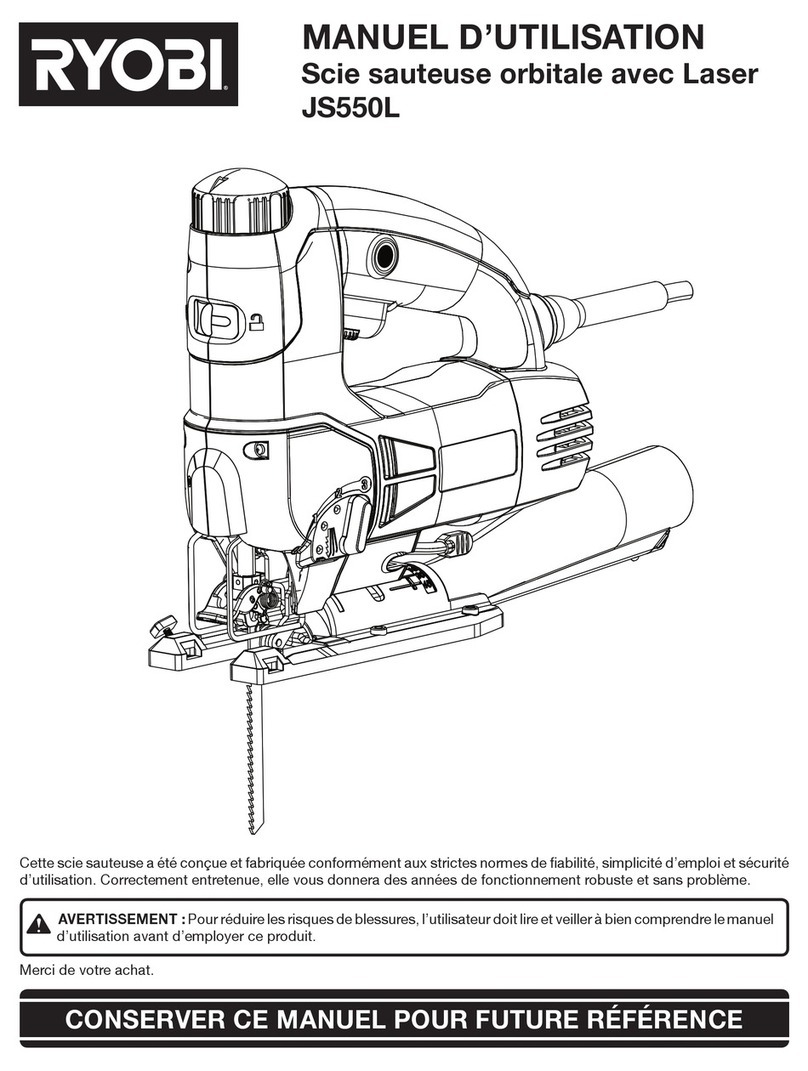
Ryobi
Ryobi JS550LK Configuration guide

Ryobi
Ryobi RP4206 User manual
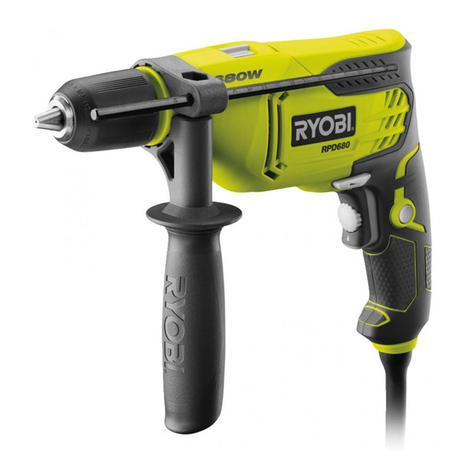
Ryobi
Ryobi RPD680 User manual
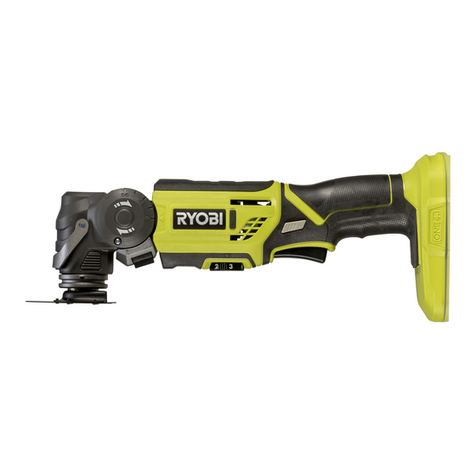
Ryobi
Ryobi R18MT User manual
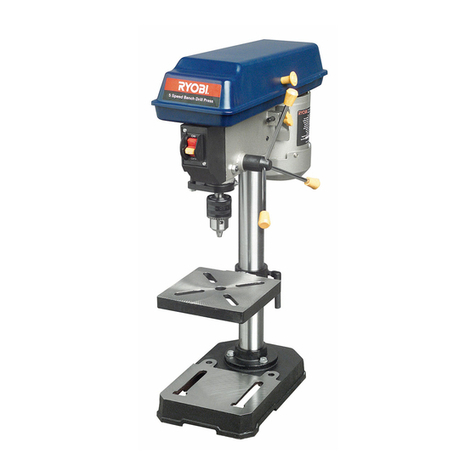
Ryobi
Ryobi BD513 Operation manual
